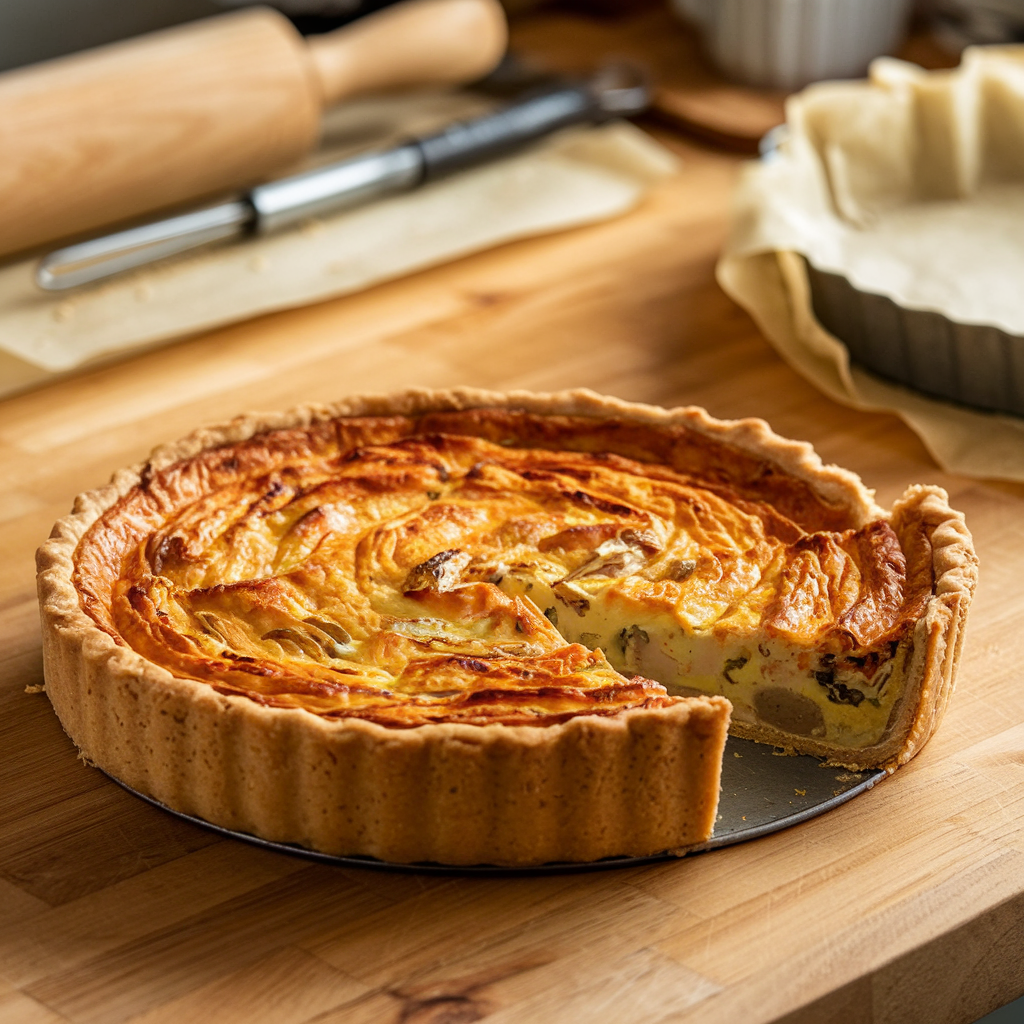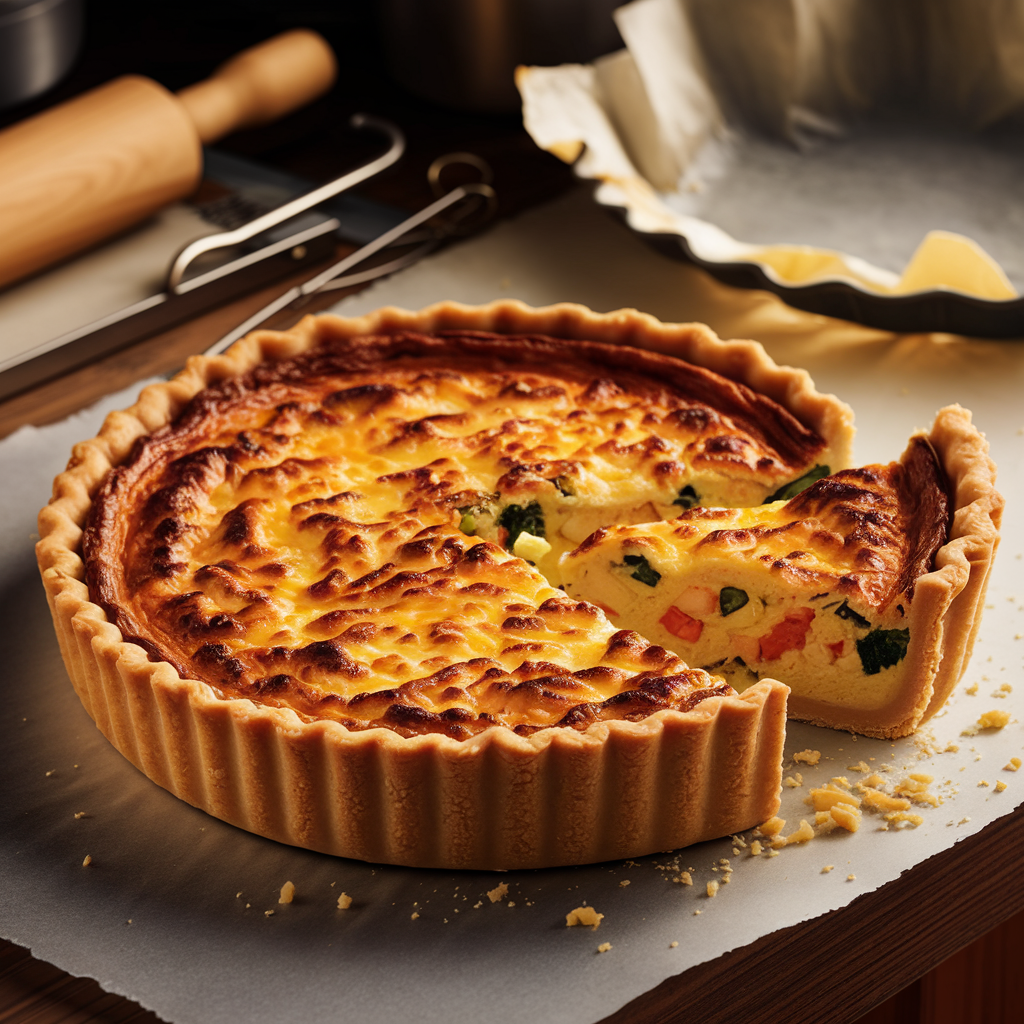Introduction
If you’ve ever made quiche at home or thought about preparing one, you’ve probably wondered: Does the quiche crust need to be pre-baked? The short answer is yes — but like most culinary questions, there’s a bit more to it. Pre-baking (also called “blind baking”) the crust for quiche is a common step in many recipes, but whether you need to do it depends on several factors, including the type of crust, the quiche filling, and your desired result.
In this article, we’ll explore everything you need to know about pre-baking quiche crusts, why it’s important, and how to do it properly. We’ll also take a look at alternative methods, so you can decide which approach is best for your quiche-making endeavors.
What Is Quiche?
Before diving into the crust, let’s take a moment to discuss what a quiche is. A quiche is a savory French dish consisting of a pastry crust filled with eggs, milk or cream, cheese, and other ingredients like vegetables, meat, or seafood. The most famous version of quiche is quiche Lorraine, which includes bacon or lardons, but the possibilities for fillings are endless.
Making quiche from scratch is a rewarding culinary experience, but it’s essential to get the crust right. The crust is the foundation of your quiche, and getting it crisp and perfectly baked can make the difference between a soggy mess and a golden, flaky masterpiece.
What Does Pre-Baking a Quiche Crust Do?
Pre-baking a quiche crust, or “blind baking,” is the process of baking the crust before adding the quiche filling. The reason for this is simple: quiche fillings (especially those made with cream or custard) often contain a lot of moisture. If you don’t pre-bake the crust, it can become soggy or undercooked as the filling releases liquid during baking.
By pre-baking the quiche crust, you ensure the crust remains crisp and golden, preventing it from absorbing excess moisture and becoming soggy. This is especially important when your quiche filling is particularly watery, such as in the case of spinach or mushrooms.
Does Quiche Crust Always Need to Be Pre-Baked?
While pre-baking a quiche crust is generally recommended for a crispier result, there are certain scenarios where you might skip the pre-baking process. Let’s break down the factors that can influence whether you should pre-bake your quiche crust:
1. Type of Crust
The type of crust you use can impact whether or not it needs to be pre-baked. For example:
- Store-bought crusts: Many pre-made pie crusts come partially cooked, so they don’t require as much pre-baking. If you’re using a store-bought crust, check the packaging for instructions.
- Homemade shortcrust pastry: If you’re making your own crust from scratch, especially with a buttery shortcrust pastry, pre-baking is often essential to achieving the right texture.
- Pre-baked frozen crusts: Some frozen crusts are designed to be used without pre-baking, so be sure to read the instructions to avoid overbaking.
2. Moisture Content of the Filling
If your quiche filling is made with ingredients that release a lot of water (like mushrooms, tomatoes, spinach, or zucchini), pre-baking the crust becomes more important. These ingredients can release moisture as they cook, making the crust soggy if it’s not pre-baked.
For fillings that are drier or less watery, you might not need to pre-bake the crust, or you can opt for a more delicate blind-baking method.
3. Desired Texture
The texture of your quiche is another key factor. If you want a crisp, flaky crust that holds its shape even after being filled with a custard-based mixture, pre-baking is highly recommended. On the other hand, if you prefer a softer crust that integrates more with the filling, skipping pre-baking might be okay.
4. Quiche Crust Thickness
Thicker crusts will generally benefit from pre-baking to ensure they cook through and don’t turn out doughy in the center. Thinner crusts, such as those made from phyllo dough or a very light pastry, might not need pre-baking.

How to Pre-Bake a Quiche Crust (Step-by-Step Guide)
If you’ve decided that pre-baking is the best approach for your quiche, here’s a simple, step-by-step guide to do it properly.
Step 1: Prepare the Crust
- Roll out your dough to fit your quiche pan. If you’re using a store-bought crust, just fit it into the pan.
- Trim the edges and crimp them if you want a decorative look.
Step 2: Chill the Crust
Before baking, it’s crucial to chill your crust in the refrigerator for at least 30 minutes. This helps prevent the dough from shrinking during the pre-baking process. If you’re in a rush, you can even freeze the crust for 10–15 minutes.
Step 3: Line with Parchment Paper
Once the crust is chilled, line it with parchment paper. This will make it easier to remove the pie weights or beans after baking. If you don’t have parchment paper, aluminum foil works too.
Step 4: Add Pie Weights or Dried Beans
Fill the parchment paper with pie weights, dried beans, or rice to weigh down the crust. This prevents the crust from puffing up or shrinking as it bakes.
Step 5: Bake the Crust
Preheat your oven to 375°F (190°C). Place the quiche crust on the middle rack and bake it for 15–20 minutes, or until the edges are golden brown.
Step 6: Remove Weights and Bake Again
After the initial baking, remove the parchment paper and weights. Return the crust to the oven for an additional 5–10 minutes to allow the bottom to brown and crisp up.
Step 7: Let the Crust Cool
Once the crust is pre-baked, let it cool slightly before adding your quiche filling. This ensures the filling won’t cause the crust to soften before it has time to bake properly.

What Are the Alternatives to Pre-Baking a Quiche Crust?
While pre-baking a quiche crust is generally the best method, there are a few alternatives that might work in certain cases:
1. Blind Baking with No Weights:
If you want a more delicate crust, you can blind bake without using weights. This method works best for crusts that are very thin and won’t shrink much during baking. You’ll need to bake for a shorter time (around 10–12 minutes) and carefully watch for any puffing or shrinking.
2. Freezing the Crust:
Another option is to freeze the crust for 30 minutes to an hour before filling it. Freezing helps the dough hold its shape during baking, reducing the risk of shrinking. This method is often used for quiche recipes where the filling isn’t overly watery.
3. No Pre-Bake:
In some cases, particularly with less watery fillings or very thin crusts, you can skip the pre-baking entirely. Just fill the crust and bake it in one go, though be prepared for a softer crust at the bottom. This method is most commonly used with store-bought crusts that are already partially cooked.
FAQ: Does Quiche Crust Need to Be Pre-Baked?
1. Can I skip pre-baking the quiche crust?
Yes, you can skip pre-baking the quiche crust, but it’s not recommended for most recipes. Pre-baking helps ensure the crust remains crispy and doesn’t become soggy from the moisture in the quiche filling. If you’re using a store-bought crust or making a quiche with minimal liquid in the filling, you may be able to skip this step. However, for best results, especially with homemade crusts or watery fillings, pre-baking is ideal.
2. What happens if I don’t pre-bake the quiche crust?
If you don’t pre-bake the quiche crust, the moisture from the filling can soak into the dough, making the bottom of the crust soggy. This could also lead to an undercooked, doughy texture. Pre-baking helps create a barrier, allowing the crust to stay crisp and golden.
3. How long should I pre-bake a quiche crust?
The typical pre-baking time for a quiche crust is around 15–20 minutes at 375°F (190°C), followed by an additional 5–10 minutes without the weights. This ensures the crust edges are golden brown and the bottom of the crust is fully cooked. If you’re using a thinner crust or smaller pan, the baking time may be shorter.
4. What is “blind baking” a quiche crust?
Blind baking is the process of pre-baking a pie or tart crust without any filling. This is done by first lining the unbaked crust with parchment paper or foil, then adding pie weights or dried beans to prevent the crust from puffing up or shrinking while it bakes. After an initial bake, the weights are removed, and the crust is baked a little longer to crisp up completely.
5. Can I use aluminum foil instead of parchment paper when blind baking?
Yes, you can use aluminum foil instead of parchment paper for blind baking. Both materials help to hold the pie weights in place and prevent the crust from puffing up. Just make sure the foil is pressed tightly against the crust to avoid any gaps that might cause uneven baking.
6. Can I freeze a quiche crust before baking?
Yes, you can freeze a quiche crust before baking. Freezing the crust helps prevent shrinkage during baking and can also give you a flakier result. After assembling the crust, place it in the freezer for at least 30 minutes before baking. If you’re using a frozen crust, you can often bake it directly from the freezer without pre-baking, but check the instructions for specific guidance.
Conclusion
In conclusion, whether or not you should pre-bake your quiche crust depends on the type of crust, the moisture content of your filling, and your desired texture. For a crisp, golden, and flaky result, pre-baking is generally the best option. This is especially true for homemade crusts or fillings that contain a lot of moisture.
Pre-baking doesn’t need to be difficult — just follow the simple steps outlined in this guide to ensure your quiche crust is perfectly crisp and ready to hold your delicious filling.
Remember: Quiche is all about balance. If you’ve never pre-baked a quiche crust before, try it and see the difference it makes. It’s a small step that results in a much better quiche.

